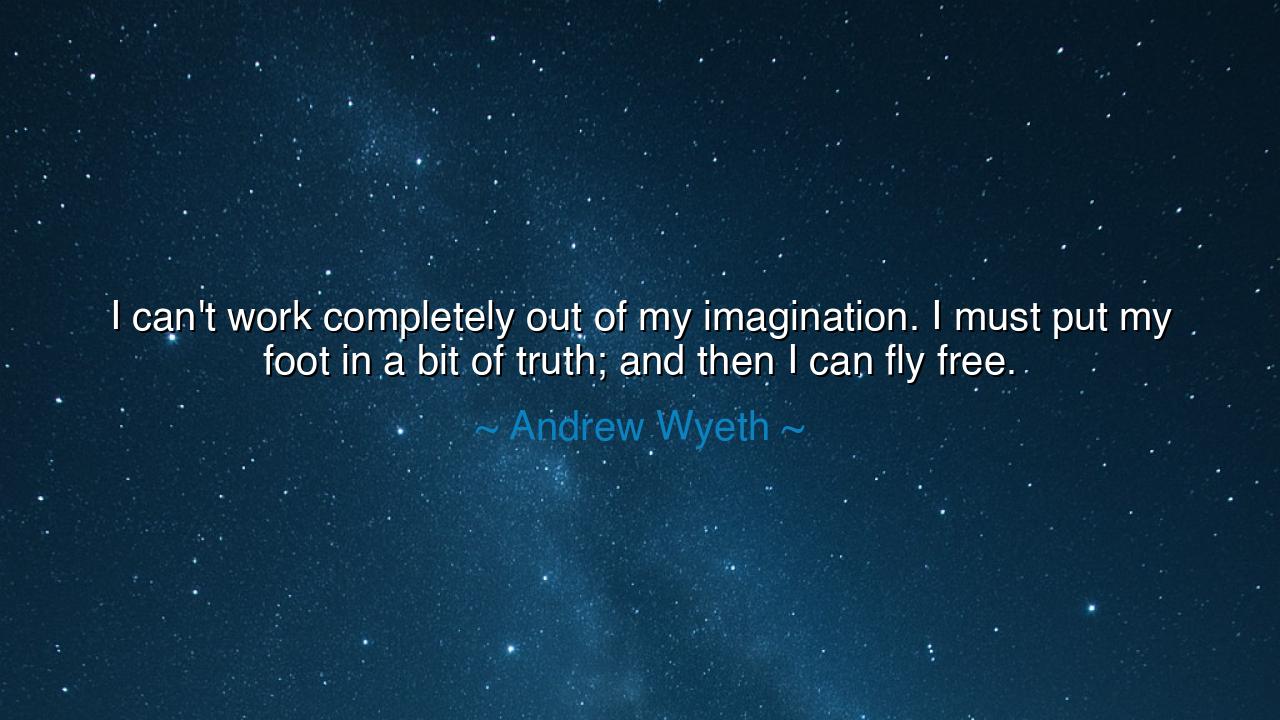
I can't work completely out of my imagination. I must put my foot
I can't work completely out of my imagination. I must put my foot in a bit of truth; and then I can fly free.






In the wise and reflective words of Andrew Wyeth, painter of quiet truths and haunting beauty, we find a lesson that speaks to every soul who seeks to create or to live authentically: “I can't work completely out of my imagination. I must put my foot in a bit of truth; and then I can fly free.” In this simple confession lies an eternal balance — between earth and sky, between the truth that anchors us and the imagination that sets us free. Wyeth’s words remind us that the wings of creativity cannot take flight without first touching the solid ground of reality. For truth is the root from which all imagination draws its life, and imagination is the flower that gives that truth its fragrance and color.
Wyeth was a man who painted not the grand or the ornate, but the quiet and the familiar — a field of dry grass, a farmhouse window, the face of a solitary figure. Yet within these humble subjects, he revealed the infinite. His art, though realistic, shimmered with imagination, with emotional light unseen by the naked eye. When he says he must “put his foot in a bit of truth,” he means that all his visions — no matter how dreamlike — must begin from something real, something honest. A stone, a shadow, a memory, or the curve of a hill — these became the foundation upon which his spirit could build its dream. He understood that truth is not the enemy of imagination but its compass, guiding it toward meaning.
The origin of this quote lies in Wyeth’s lifelong devotion to place and presence. He lived most of his life in the rural landscapes of Pennsylvania and Maine, drawing inspiration from the people and scenes around him. His works — such as Christina’s World — reveal the meeting of two realms: the tangible and the imagined. The figure of Christina, crawling through the grass toward a distant farmhouse, was based on a real woman, but Wyeth’s brush transformed her struggle into something eternal — the yearning of the human spirit. He did not invent from nothing; he began with truth and then let imagination lift that truth into universality. In this way, Wyeth teaches us that the highest art is not escape from reality, but a deepened vision of it.
Throughout history, this union of truth and imagination has been the mark of greatness. Consider Leonardo da Vinci, who studied anatomy, light, and motion not to enslave his art to science, but to free it. He placed his foot firmly in the truth of nature’s laws, and from that grounding, his imagination soared. The angelic faces of his paintings, the flying machines of his sketches, the swirling movements of his figures — all sprang from his reverence for reality. Similarly, William Shakespeare, though his stories unfolded in kingdoms and dreams, always began with the raw truth of human emotion. He observed love, jealousy, ambition, and despair, and then, through imagination, turned them into poetry that has never faded.
Wyeth’s insight also reveals a greater spiritual law: truth and imagination are the twin forces of creation, in art as in life. The truth keeps us honest, humble, and grounded in what is real; imagination keeps us alive, curious, and open to what is possible. One without the other is incomplete. Truth without imagination becomes rigidity — the lifeless repetition of facts. Imagination without truth becomes illusion — the fragile dream that collapses under its own weight. The wise creator, the wise soul, knows that the foot must touch the earth before the wings can find the sky.
And yet, there is a deeper meaning still. In life itself, as in art, we must each find our “bit of truth” — that place or experience that grounds us. It might be the love of a family, the memory of home, the discipline of work, or the conviction of purpose. Once we stand upon that foundation, we can dream without fear, we can act without losing our way. For as Wyeth teaches, when the imagination flies from the firm ground of truth, it does not wander aimlessly — it soars with direction and grace. The higher we wish to climb, the deeper our roots must reach.
So, my child, take this teaching into your heart: when you seek to create, to dream, or to build your life, do not despise reality, nor fear it. Embrace it. Begin with what is true — a moment, a feeling, a fact — and from that seed, let your imagination grow. Ground your art, your work, your love, in the soil of sincerity, and it will blossom into something eternal. Do not try to fly without first standing firm, but once your foot is set upon the truth, then lift your eyes and let your spirit rise.
For as Andrew Wyeth reminds us, the true artist, and indeed the true human being, lives between two worlds — one of earth and one of sky. To deny either is to cripple the soul. But to balance both, to find freedom through grounding and flight through faith — that is to live as the ancients lived, and to create as the gods once dreamed. Truth is the earth beneath you; imagination is the wind that carries you beyond it.






AAdministratorAdministrator
Welcome, honored guests. Please leave a comment, we will respond soon